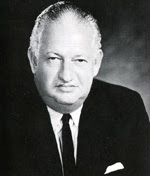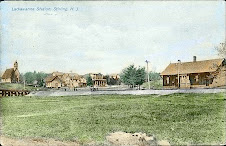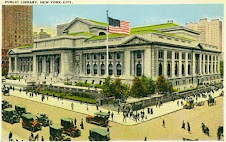.gif) On Halloween eve, 1938, people were listening to Orson Welles's Mercury Theatre Presentation on CBS radio, enjoying the music of Ramon Raquello and his Orchestra. Suddenly, an announcer interrupted the show with a news bulletin that an astronomer had sighted an "incandescent gas" emanating from the planet Mars. Afterwards, the network reverted to its regularly-scheduled programming, only to be preempted by another emergency news report, which informed its listening audience that a "huge flaming object" struck a farm in Grover's Mill, New Jersey. A newscaster at the scene of the crash, in an alarmed voice, said that an alien emerged from what appeared to be a spacecraft, and "it glistens like wet leather. But that face-- it... it is indescribable." The alien invaders then turn on the gathering crowd of onlookers at the farm in Grover's Mill, and fire their "heat rays" on them.
On Halloween eve, 1938, people were listening to Orson Welles's Mercury Theatre Presentation on CBS radio, enjoying the music of Ramon Raquello and his Orchestra. Suddenly, an announcer interrupted the show with a news bulletin that an astronomer had sighted an "incandescent gas" emanating from the planet Mars. Afterwards, the network reverted to its regularly-scheduled programming, only to be preempted by another emergency news report, which informed its listening audience that a "huge flaming object" struck a farm in Grover's Mill, New Jersey. A newscaster at the scene of the crash, in an alarmed voice, said that an alien emerged from what appeared to be a spacecraft, and "it glistens like wet leather. But that face-- it... it is indescribable." The alien invaders then turn on the gathering crowd of onlookers at the farm in Grover's Mill, and fire their "heat rays" on them. More bulletins came into the radio station-- railroads, bridges, and cities were blown up by the Martians throughout the United States. The U.S. military proved unable to fight the aliens, who began to spray poison gas through the air as they advanced toward New York City. As a reporter was broadcasting from the top of the CBS building in New York, the Martians began to invade New York, and he, like many others, collapsed from the effects of the poison gas. Towards the end of the broadcast, all that was heard was a ham radio operator repeating "2X2L calling CQ.. Isn't anyone on the air? Isn't anyone on the air? Isn't there... anyone?" The world was saved, though, as the Martians died from exposure to germs and bacteria present on Earth.
Obviously, Martians never landed on that day in Grover's Mill, New Jersey, or anywhere else. It was Orson Welles's dramatization of H.G. Wells's War of the Worlds that was broadcast that evening (for the orginal audio broadcast in its entirety, click here). Although disclaimers announcing that the program was a fictional account were run before the show began, at twenty minutes into the broadcast, and at the forty-minute mark of the hour, there were reports of panic in the newspapers the next day.
In Newark, New Jersey, fifteen people were treated for shock at St. Michael's Hospital; twenty families in the same city wrapped themselves in wet towels, and created traffic jams as they searched for gas masks, the police, and ambulances. Meanwhile, further south, scientists from Princeton University set out in search of the first Martian landing site in nearby Grover's Mill. The Memphis Press-Scimitar called in its editorial staff to run a special edition on the Martian bombings of Chicago and St. Louis, and the pending invasion of Memphis. The New York Times alone received 875 telephone calls from panic-stricken listeners of the program. The Associated Press, consequently, issued a bulletin reassuring the public that the world was not coming to an end.
How h ad so many been taken in by the fictionalized account of the Martian invasion? One of the reasons was the realistic style that Orson Welles used in creating the fictional newsflashes, perfectly mimicking CBS radio's emergency news broadcast procedure. Many radio listeners, however, missed the disclaimers for the Mercury Theatre Presentation on CBS, as they were tuned in to the Chase and Sanborn Hour on NBC, which was hosted by Don Ameche, and featured Edgar Bergen and Nelson Eddy as the entertainment for that show. After the first comedy act on the Chase and Sanborn show was over, many in the listening audience began tuning around the dial, and came upon the War of the Worlds broadcast as the first "newsflashes" were broadcast, not realizing that what they were hearing was a fictional account. Orson Welles apparently was well aware that many listeners would tune into his Mercury Theatre Presentation after Chase and Sanborn's first act, and deliberately timed the first "news report" to coincide with it.
ad so many been taken in by the fictionalized account of the Martian invasion? One of the reasons was the realistic style that Orson Welles used in creating the fictional newsflashes, perfectly mimicking CBS radio's emergency news broadcast procedure. Many radio listeners, however, missed the disclaimers for the Mercury Theatre Presentation on CBS, as they were tuned in to the Chase and Sanborn Hour on NBC, which was hosted by Don Ameche, and featured Edgar Bergen and Nelson Eddy as the entertainment for that show. After the first comedy act on the Chase and Sanborn show was over, many in the listening audience began tuning around the dial, and came upon the War of the Worlds broadcast as the first "newsflashes" were broadcast, not realizing that what they were hearing was a fictional account. Orson Welles apparently was well aware that many listeners would tune into his Mercury Theatre Presentation after Chase and Sanborn's first act, and deliberately timed the first "news report" to coincide with it.
 ad so many been taken in by the fictionalized account of the Martian invasion? One of the reasons was the realistic style that Orson Welles used in creating the fictional newsflashes, perfectly mimicking CBS radio's emergency news broadcast procedure. Many radio listeners, however, missed the disclaimers for the Mercury Theatre Presentation on CBS, as they were tuned in to the Chase and Sanborn Hour on NBC, which was hosted by Don Ameche, and featured Edgar Bergen and Nelson Eddy as the entertainment for that show. After the first comedy act on the Chase and Sanborn show was over, many in the listening audience began tuning around the dial, and came upon the War of the Worlds broadcast as the first "newsflashes" were broadcast, not realizing that what they were hearing was a fictional account. Orson Welles apparently was well aware that many listeners would tune into his Mercury Theatre Presentation after Chase and Sanborn's first act, and deliberately timed the first "news report" to coincide with it.
ad so many been taken in by the fictionalized account of the Martian invasion? One of the reasons was the realistic style that Orson Welles used in creating the fictional newsflashes, perfectly mimicking CBS radio's emergency news broadcast procedure. Many radio listeners, however, missed the disclaimers for the Mercury Theatre Presentation on CBS, as they were tuned in to the Chase and Sanborn Hour on NBC, which was hosted by Don Ameche, and featured Edgar Bergen and Nelson Eddy as the entertainment for that show. After the first comedy act on the Chase and Sanborn show was over, many in the listening audience began tuning around the dial, and came upon the War of the Worlds broadcast as the first "newsflashes" were broadcast, not realizing that what they were hearing was a fictional account. Orson Welles apparently was well aware that many listeners would tune into his Mercury Theatre Presentation after Chase and Sanborn's first act, and deliberately timed the first "news report" to coincide with it. The U.S. public, upon realizing it was a fictional account, became indignant, and flooded the FCC with complaints. This resulted in the censure of Orson Welles and the Mercury Theatre, and CBS was ordered to never use the phrase "we interrupt this program" for dramatic effect. Welles had said that the War of the Worlds presentation was meant to be "the Mercury Theatre's own version of dressing up in a sheet, and saying, Boo!" Later, he regretted making the decision to air the program, and said , "I don't think we will choose anything like this again."
 As the years went by, the U.S. public seemed to forgive Welles for his clever prank. Today, various radio stations around the nation re-broadcast the War of the Worlds every Halloween. In 1988, on the fiftieth anniversary of the original broadcast on CBS, West Windsor Township, New Jersey (in which Grover's Mill is located) held a Martian festival, which culminated with the unveiling of the Martian Landing Monument in Van Ness Park (left). Near the Grover's Mill Company, the water tower that nervous residents shot into pieces that fateful night in 1938 still stands for all who pass the area today.
As the years went by, the U.S. public seemed to forgive Welles for his clever prank. Today, various radio stations around the nation re-broadcast the War of the Worlds every Halloween. In 1988, on the fiftieth anniversary of the original broadcast on CBS, West Windsor Township, New Jersey (in which Grover's Mill is located) held a Martian festival, which culminated with the unveiling of the Martian Landing Monument in Van Ness Park (left). Near the Grover's Mill Company, the water tower that nervous residents shot into pieces that fateful night in 1938 still stands for all who pass the area today.So, the next time your favorite program is interrupted by a "Special Report"...
Sources:
"Boo!" Time, 7 November 1938. Online http://www.time.com/time/magazine/article/0,9171,788886-1,00.html. Text downloaded 21 October 2007.Lovgen, Stefan. "War of the Worlds: Behind the Radio Show Panic," National Geographic News, 17 June 2005. Online http://news.nationalgeographic.com/news/2005/06/0617_050617_warworlds.html. Text downloaded 21 October 2007.






